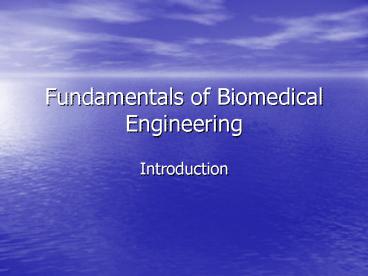Fundamentals of Biomedical Engineering - PowerPoint PPT Presentation
1 / 14
Title:
Fundamentals of Biomedical Engineering
Description:
Expensive and costs rising due to new technology ... Andorra. 82.67. 3. Japan. 82.07. 4. Singapore. 81.89. 8. Sweden. 80.63. 9. Australia. 80.62. 10 ... – PowerPoint PPT presentation
Number of Views:1356
Avg rating:3.0/5.0
Title: Fundamentals of Biomedical Engineering
1
Fundamentals of Biomedical Engineering
- Introduction
2
Biomedical Engineering
- Electrical, mechanical, chemical, material
systems engineering - Biology
- Medicine
- Maths
- Physics
- Chemistry
- Computer science
3
Health Care
- Expensive and costs rising due to new technology
(biomedical engineering) - USA 16 of Gross Domestic Product (GDP)
- Australia 9.5 GDP
- UK 8.0 GDP
- New technology must be cost effective
- Insatiable demand for treatment, so rationed
- Availability (queues)
- Price
- Human life worth Aus200,000
4
Health Care Costs
5
Outcomes Life Expectancy
6
Outcomes Infant Mortality
7
Outcomes child maternal mortality rates
8
Outcomes health life expectancy
9
Input health spending
10
What Gives Rise to Good Health?
- High spending on health does not necessarily
correlate with good health (e.g. USA) - Public health preventative medicine important
- Countries that have moved from 3rd world status
to 1st world status have spent most of their
money on health care in the early stages of
development (Prof. Hans Rosling)
11
Biomedical Engineeringan Interdisciplinary
Science
- Communication between medical practitioner and
engineer is critical - Easier for engineer to learn medical jargon than
vice versa - Essential to understand medical problem
- Different philosophies
- Medicine is an art requiring value judgments
- Engineering is more scientific, mathematical and
hierarchical
12
Similarities of Biomedical Engineering and
Medicine
- Collection of data (monitoring of patients)
- Analysis of data (reduction or transformation)
- Decision making (diagnosis)
- Therapy
- Preventive medicine
13
Mathematical Modelling
- Biological systems are complex, easily damaged,
so not all parts are observable - Mathematical model can be used to predict
unobservable parts of system using observable
parts as inputs
14
Control of Biological Systems
- Simple proportional, integral and differential
control systems (PID) - Model reference adaptive control e.g.
- After cardiac surgery, heart is weak, blood
pressure through major organs (brain, heart,
kidneys) is critical, not easily measured - Drugs that stimulate or relax the heart injected
by motorised pump - Blood pressure measured at arm
- Blood pressure at brain, heart, kidneys
calculated from model - Model adapts from response to disturbances
created by periodic fixed injections of different
drugs































